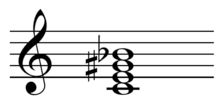Augmented seventh chord

| Component intervals from root | |
|---|---|
| minor seventh | |
| augmented fifth | |
| major third | |
| root | |
| Tuning | |
| 80:100:125:144 | |
| Forte no. / | |
|
4-24 / |
The augmented seventh chord ![]() Play , or seventh augmented fifth chord,[1]
or seventh sharp five chord is a dominant seventh chord consisting of an augmented triad with a minor seventh.[2] Thus, it consists of a root, major third, augmented fifth, and the minor seventh.[3]
Thus in the key of C major it would be C, E, G-sharp, and B-flat as in the figure. It may be notated with the chord symbols Cm+7, Cmaug7, C+7, Caug7, [3] or C7♯5, and can be represented by the integer notation {0, 4, 8, 10}.
Play , or seventh augmented fifth chord,[1]
or seventh sharp five chord is a dominant seventh chord consisting of an augmented triad with a minor seventh.[2] Thus, it consists of a root, major third, augmented fifth, and the minor seventh.[3]
Thus in the key of C major it would be C, E, G-sharp, and B-flat as in the figure. It may be notated with the chord symbols Cm+7, Cmaug7, C+7, Caug7, [3] or C7♯5, and can be represented by the integer notation {0, 4, 8, 10}.
The root is the only optional note in an augmented seventh chord, the fifth being required because it is raised.[4] This alteration is useful in the major mode because the raised 5th creates a leading tone to the 3rd of the tonic triad.[2] See also dominant.
In rock parlance, the term Augmented seventh chord is sometimes confusingly and erroneously used to refer to the so-called "Hendrix chord", a 7♯9 chord which contains the interval of an augmented ninth but not an augmented fifth.[5]

The augmented minor seventh chord may be considered an altered dominant seventh and may use the whole-tone scale, as may the dominant seventh flat five chord.[7] See chord scale system.

The augmented seventh chord normally resolves to the chord a perfect fifth below,[8] thus G7+5 resolves to a C major chord, for example.
Augmented seventh chord table
| Chord | Root | Major third | Augmented fifth | Minor seventh |
|---|---|---|---|---|
| Caug7 | C | E | G♯ | B♭ |
| C♯aug7 | C♯ | E♯ (F) | G |
B |
| D♭aug7 | D♭ | F | A | C♭ (B) |
| Daug7 | D | F♯ | A♯ | C |
| D♯aug7 | D♯ | F |
A |
C♯ |
| E♭aug7 | E♭ | G | B | D♭ |
| Eaug7 | E | G♯ | B♯ (C) | D |
| Faug7 | F | A | C♯ | E♭ |
| F♯aug7 | F♯ | A♯ | C |
E |
| G♭aug7 | G♭ | B♭ | D | F♭ (E) |
| Gaug7 | G | B | D♯ | F |
| G♯aug7 | G♯ | B♯ (C) | D |
F♯ |
| A♭aug7 | A♭ | C | E | G♭ |
| Aaug7 | A | C♯ | E♯ (F) | G |
| A♯aug7 | A♯ | C |
E |
G♯ |
| B♭aug7 | B♭ | D | F♯ | A♭ |
| Baug7 | B | D♯ | F |
A |
See also
Sources
- ↑ Kroepel, Bob (1993). Mel Bay Creative Keyboard's Deluxe Encyclopedia of Piano Chords: A Complete Study of Chords and How to Use Them, p.15. ISBN 0-87166-579-4.
- 1 2 "The Dominant with a Raised 5th", Kostka, Stefan, and Dorothy Payne. 2004. Tonal Harmony with an Introduction to Twentieth-Century Music. 6th Ed. pp. 446-447. New York. ISBN 978-0-07-332713-6.
- 1 2 Garner, Robert (2007). Mel Bay presents Essential Music Theory for Electric Bass, p.69. ISBN 0-7866-7736-8.
- ↑ Latarski, Don (1991). An Introduction to Chord Theory, p.29. ISBN 0-7692-0955-6.
- ↑ Radio: "Shiver down the backbone - Jimi Hendrix comes to Radio 3", The Spectator, by Kate Chisholm, Wednesday, 21 November 2007
- ↑ Hatfield, Ken (2005). Jazz and the Classical Guitar Theory and Applications, p.121. ISBN 0-7866-7236-6.
- ↑ Berle, Annie (1996). Contemporary Theory And Harmony, p.100. ISBN 0-8256-1499-6.
- ↑ Bay, William (1994). Mel Bay Complete Jazz Sax Book, p.64. ISBN 0-7866-0229-5.